Z tego dokumentu dowiesz się, jak używać interfejsu Nearby Search (New) API do tworzenia prostej i opłacalnej
lokalnych treści.
Gdy użytkownik szuka hotelu lub nieruchomości, w ramach lokalnego odkrywania wyświetlają mu się najważniejsze miejsca w pobliżu lokalizacji, którą określisz. Często składa się z interaktywnej mapy i dodatkowego panelu z wyborem miejsca oraz galerią zdjęć. Zobaczysz różne usługi i funkcje Platformy Map Google, które pozwolą Ci zwiększyć interaktywność.
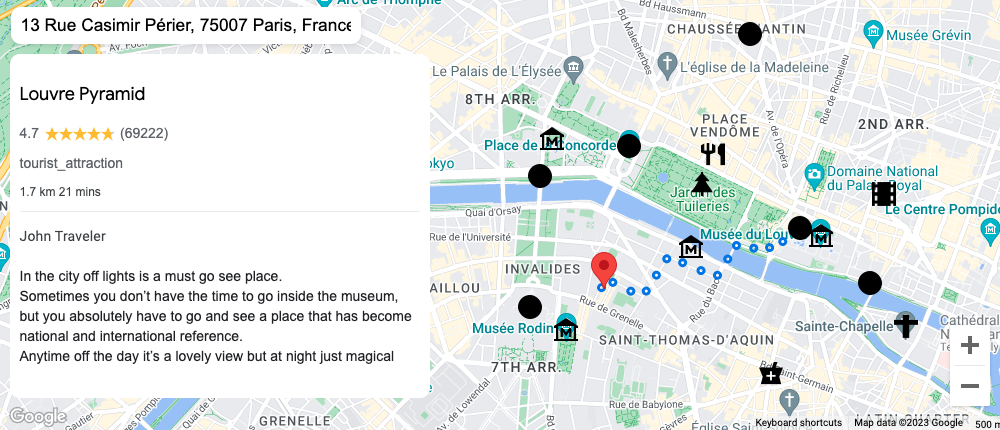
Przypadki użycia
Przyjrzyjmy się teraz, które elementy integracji odkrywania lokalnego zwiększają wartość dla użytkownika:
Odkrywanie – przedstaw użytkownikom przegląd tego, co znajduje się w pobliżu danego miejsca, wyświetlając odpowiednie miejsca różnych typów.
Interaktywność – umożliwia użytkownikom wybieranie miejsca i dynamiczne odświeżanie danych.
w stosunku do tego miejsca.
Wizualizacja – przesyłanie opinii o miejscach i zdjęć
oraz czas i odległość, które użytkownicy muszą pokonać pieszo, aby szybko sprawdzić, czy spełnia to ich potrzeby.
Architektura referencyjna
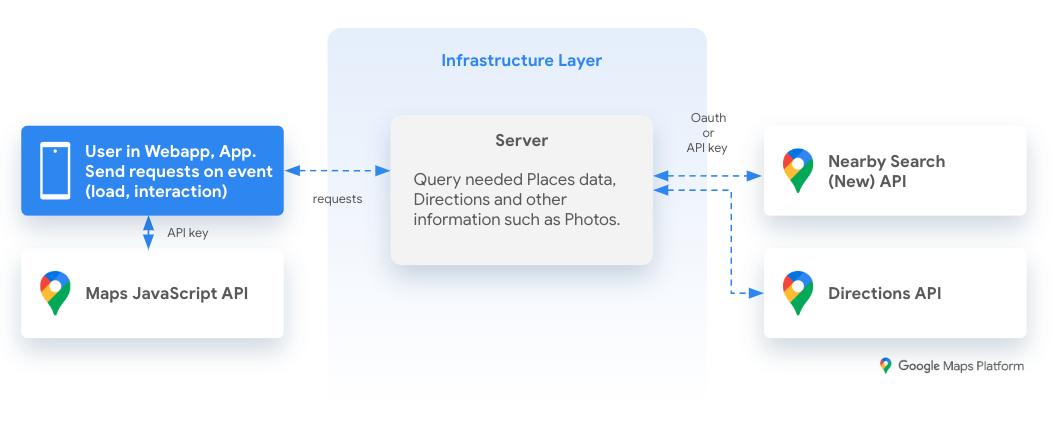
Odkrywanie lokalnych miejsc
Możesz tworzyć lokalne wrażenia na wiele sposobów. Poniższa integracja to niestandardowy przykład interfejsu użytkownika, który wykorzystuje znane interfejsy Google Maps Platform API, a także kilka nowych, ciekawych funkcji. Jeśli chcesz zastosować podejście oparte na szablonach do odkrywania lokalnego, możesz użyć komponentów internetowych.
Przykładowa aplikacja
Przykładowy przewodnik
W tabeli poniżej znajdziesz przykładową aplikację podzieloną na etapy wraz z opisem implementacji technicznej za pomocą interfejsów Google Maps Platform API.
1. Wyszukiwanie lokalizacji z autouzupełnianiemWyszukiwanie lokalizacji
- Wczytaj Maps JavaScript API.
- Zapytanie autouzupełniania miejsc lub wybierz lokalizację na mapie.
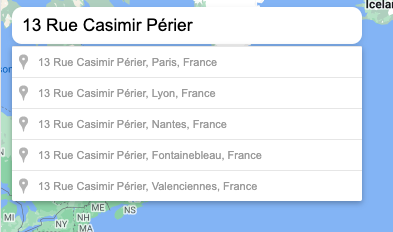
2. Wyświetlanie lokalnych ciekawych miejsc za pomocą interfejsu Nearby Search (New) API
- ranking popularności (trafniejsze wyniki) lub ranking odległości.
includedTypes,excludedTypes; jeśli prowadzisz hotel, możesz wykluczyć typ „obiekt noclegowy” i uwzględnić tylko odpowiednie typy, np. „restauracja, kawiarnia, park, atrakcja_turystyczna”.- Wykorzystaj
includedPrimaryTypes,excludedPrimaryTypes, aby mieć jeszcze większą kontrolę nad wynikami. - `locationRestriction, aby uniknąć niewystarczającej liczby wyników lub zbyt odległych miejsc; w przypadku BRAKU wyników zwiększ rozmiar okręgu lub prostokąta przed wyświetleniem wyników.
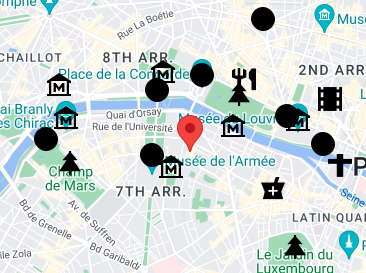
Przykładowe zapytanie podczas rezerwowania hotelu z wymaganymi polami danych:
- Podstawowe (
displayName,types,openingHours,formattedAddress) - Kontakt (
websiteUri,nationalPhoneNumber,internationalPhoneNumber) - Preferowane (
reviews,priceLevel,userRatingCount)
{ "includedTypes": ["restaurant","cafe","park"], "excludedTypes":
["lodging","convenience_store"], "includedPrimaryTypes":
["restaurant","tourist_attraction","airport"], "excludedPrimaryTypes":
["lodging"], "maxResultCount": 20, "locationRestriction": { "circle": {
"center": { "latitude": 37.7937, "longitude": -122.3965 }, "radius": 500.0 } } }Przykładowe zapytanie podczas wyszukiwania nieruchomości z wymaganymi polami danych:
- Podstawowe (
displayName,types,openingHours,formattedAddress)
{ "includedTypes": ["school","transport","bus","convenience_store"],
"excludedTypes": ["lodging"], "includedPrimaryTypes":
["restaurant","tourist_attraction","airport"], "excludedPrimaryTypes":
["lodging"], "maxResultCount": 20, "locationRestriction": { "circle": {
"center": { "latitude": 37.7937, "longitude": -122.3965 }, "radius": 500.0 } } }3. Dodawanie interaktywności za pomocą interfejsów Dynamic Maps i Directions API
- Aktualizuj długość trasy i liczbę kroków, wysyłając zapytania do interfejsu Directions API. * Użyj czasu w następnej sekcji.
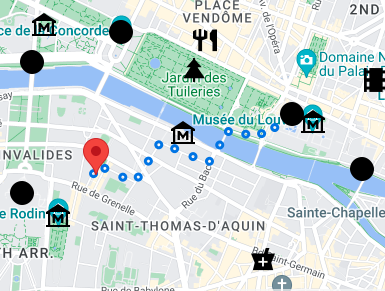
4. wyświetlać szczegółowe informacje o miejscu po interakcji,
Opis:
displayName,types,rating,userRatingCount,priceLevel.Czas: pochodzi z poprzedniego zapytania do interfejsu Directions API.
Opinie:
reviews[i].author,reviews[i].rating,reviews[i].text.Obrazy: podczas nieograniczonego podglądu interfejsu Nearby Search (New) API musisz wysyłać zapytania do Places Details z parametrem
place.id, aby uzyskać photo_reference, a następnie wysyłać zapytania pojedynczo w swojej usłudze.
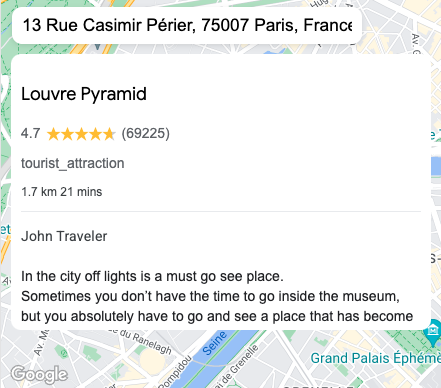
Liczba zapytań i powiązane koszty
- Maps JavaScript API: 1 mapa podczas wczytywania usługi.
- Interfejs Places Autocomplete API: 1 zapytanie na każdy wpisany znak (jeśli używasz widżetu autouzupełniania), można go dostosować.
- Nearby Search (New) API: 1 zapytanie na każde 20 wyświetlonych miejsc. Różne rozliczenia w zależności od danych o miejscu wchodzących w skład odpowiedzi na zapytanie.
- Directions API: 1 zapytanie dla każdego miejsca wybranego przez użytkownika.
- Interfejs Place Photo API: 1 zapytanie na każde wyświetlone zdjęcie.
Podsumowanie
Odkrywanie lokalnych miejsc to skuteczny sposób na dostarczanie użytkownikom wartości. Ta demonstracyjna implementacja ma wiele funkcji, które prawdopodobnie uwzględnisz podczas tworzenia takiego rozwiązania na platformie Google Maps Platform z wykorzystaniem specjalnych możliwości interfejsu Nearby Search (New) API .
Następne kroki
Sugerowane dalsze lektury:
- Komponenty sieciowe w Maps JavaScript API
- Optymalizacja autouzupełniania w Places
- Inne usługi związane z Miejscami
- Zostaw opinię poniżej.
Współtwórcy
Główni autorzy:
Thomas Anglaret | Inżynier rozwiązań Google Maps Platform

